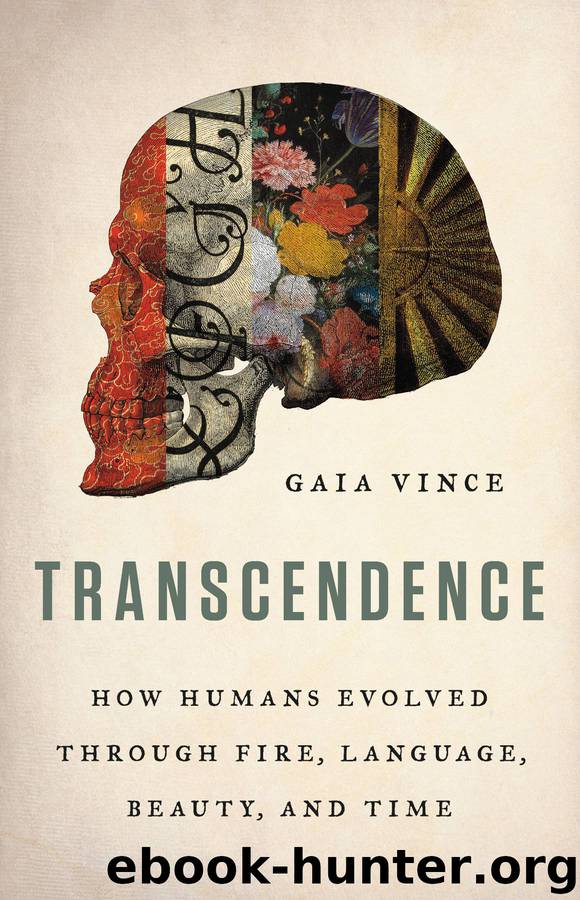Transcendence by Gaia Vince

Author:Gaia Vince
Language: eng
Format: epub
Publisher: Basic Books
Published: 2020-01-20T16:00:00+00:00
WITHIN THESE BROAD domesticating parameters, a flourishing of diverse groups practicing different social norms emerged, and these differences changed the minds and bodies of the people who practiced them. Cultural learning alters people’s brains.31 Practicing any skill involves “hardwiring” the neural networks involving muscle control and coordination, balance, judgment of speed and distance, and so on, until the skill feels automatic. Once a behavior, action, or thought process is so practiced it has become automatic, the brain’s processing workload is significantly reduced, which frees up working memory, allowing the best of us to innovate the tiny details that push the boundaries of human excellence. This applies to everything from learning to walk to becoming a concert pianist or juggler.32 People who played a lot of Pokémon as children share a specific brain region devoted to recognizing the game’s characters.33 Our cultural developing bath also affects the body—committed tennis players build up around 20 percent greater bone density on the racket-holding side of their bodies; people who spend time at high altitudes produce more red blood cells and larger lungs to cope with the decrease in available oxygen. To be clear, these are not genetic changes, but biological changes during a person’s life.
Those groups whose social norms and technologies improve health or economic outcome are more likely to survive and transmit their cultural practices to other generations. In many cases, this cultural evolution changes their biology. For example, a remote tribe of sea nomads, called the Moken, who live off the west coast of Thailand, have developed a unique dolphin-like ability to see underwater. Moken children spend much of their day in the sea diving for food, and their eyes have adapted to see twice as well as European children. Our underwater vision is usually blurry because the water refracts the light entering our eyes at the same rate as our water-filled corneas do, so we lose the ability to focus light. Moken kids, though, like seals and dolphins, have developed reflexive adaptations: their pupils constrict to the maximum known limit of human performance, thereby increasing the depth of field; and they change their lens shape. This is a biological adaptation to culture but it isn’t a genetic change; it’s a learned ability, even though it’s unconscious, which means any child can adapt. Indeed, scientists tried training Swedish children to dive down and look at patterns on a card, and after 11 sessions, the Swedes had gained the same underwater acuity as the Moken children.34
However, for the Bajau people of Indonesia, another population of sea nomads, their culturally evolved lifestyle has produced a genetic adaptation. Geneticists investigating the Bajau’s extraordinary diving ability have identified a handful of gene variants35 in their DNA that allow them to hold more oxygen in their blood and important organs, control their carbon dioxide levels, and also increase the size of their spleen, which acts as a reservoir for oxygenated blood—Bajau spleens are 50 percent larger than the average. Some of these genes appear to have
Download
This site does not store any files on its server. We only index and link to content provided by other sites. Please contact the content providers to delete copyright contents if any and email us, we'll remove relevant links or contents immediately.
| Anatomy | Animals |
| Bacteriology | Biochemistry |
| Bioelectricity | Bioinformatics |
| Biology | Biophysics |
| Biotechnology | Botany |
| Ecology | Genetics |
| Paleontology | Plants |
| Taxonomic Classification | Zoology |
Sapiens: A Brief History of Humankind by Yuval Noah Harari(14244)
The Tidewater Tales by John Barth(12608)
Mastermind: How to Think Like Sherlock Holmes by Maria Konnikova(7222)
Do No Harm Stories of Life, Death and Brain Surgery by Henry Marsh(6887)
The Thirst by Nesbo Jo(6826)
Why We Sleep: Unlocking the Power of Sleep and Dreams by Matthew Walker(6618)
Life 3.0: Being Human in the Age of Artificial Intelligence by Tegmark Max(5474)
Sapiens by Yuval Noah Harari(5293)
The Longevity Diet by Valter Longo(5017)
The Body: A Guide for Occupants by Bill Bryson(4973)
The Rules Do Not Apply by Ariel Levy(4842)
The Immortal Life of Henrietta Lacks by Rebecca Skloot(4523)
Animal Frequency by Melissa Alvarez(4394)
Why We Sleep by Matthew Walker(4358)
The Hacking of the American Mind by Robert H. Lustig(4318)
Yoga Anatomy by Kaminoff Leslie(4303)
All Creatures Great and Small by James Herriot(4228)
Double Down (Diary of a Wimpy Kid Book 11) by Jeff Kinney(4204)
Barron's AP Biology by Goldberg M.S. Deborah T(4095)
